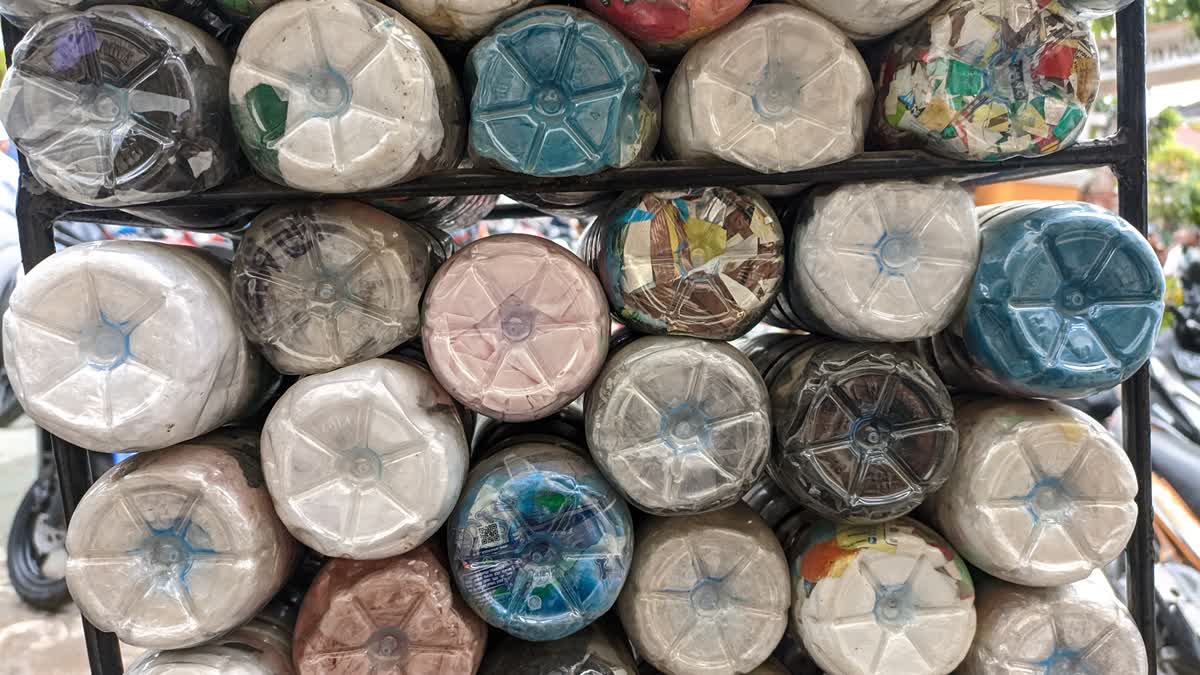Hyderabad: The general premise of an eco brick is very simple—gather all of the materials you cannot recycle at home or locally, and pack them as tightly as you can into a plastic bottle. This tight tube of plastic becomes a building block, which can then be used for a range of things from sculptures to construction projects. Could this be the best solution to plastic pollution, or do they pose more problems further down the line?
The Eco-brick movement has gained traction in recent years due to the widespread media coverage of plastic pollution. Plastic has grown in popularity as a building material, particularly in developing nations where it is incredibly common to find lying around the house or in the streets.
The eco bricks make an excellent building material when combined with other natural building techniques like wattle and daub, adobe, or cob. Because of the closely-packed insulating plastics, they also function as a natural insulator.
There is a serious issue with plastic pollution on the planet, and people are always looking for solutions. Eco bricks are one remedy that has been gaining traction. Plastic bottles filled with plastic waste are called "eco bricks," and they are used as building materials. They're an economical, eco-friendly, and inventive way to reuse plastic waste.
History of EcoBrick
The EcoBricks narrative begins in Guatemala and travels to South Africa through the Philippines. In 2003, Susanna Heisse, a Guatemalan environmental activist, created the first Eco brick construction system to address the problem of plastic pollution in Lake Atitlan communities. She used them to construct a wall that served as an inspiration to people all across the world. As a result, Greyton, one of the first towns in South Africa, created an eco village, community gardens, and schools based on this idea. Afterwards, Port Elizabeth-based architect Ian Dommisse was so moved by the idea that he founded an EcoBrick Exchange.
A network of neighborhood companies eager to provide EcoBricks with storage space and special offers, as well as neighborhood swap shops where EcoBricks can be traded for high-quality used goods.
What Is an Ecobrick?
Eco Bricks are a way to re-package plastic waste so that it becomes usable as a sturdy building block. Essentially, you take a plastic bottle of any size and stuff it to the brim with plastic waste.
Common bottle choices include single-use juice bottles, one or two-liter soda bottles, and water bottles. The finished product can be used for all sorts of projects, including building chairs, tables, walls, and more.
It's pretty simple. An ecobrick is a plastic bottle densely packed with used plastic to create a reusable building block that achieves plastic sequestration. To make one, all you need is a stick and a bottle.
Ecobricks follow Earth's example. Over the last few billion years, Earth has steadily captured loose carbon to concentrate and sequester it under the earth so that life could thrive. We're doing the same with our loose plastic (which in fact is made from that ancient carbon!) by packing and sequestering it into an ecobrick.
Ecobricks do more than just prevent plastic from polluting the biosphere. Ecobricking also keeps plastic from industrially processing-- which often creates even more problems than it solves. Best of all, eco bricks can be put to use locally to build all sorts of great green things.
Ecobricks are put to use in all sorts of ways by the global community. In the Philippines we build food forests and play parks with them. In the UK, we build earthen round houses. In Indonesia, we make modular furniture for homes and cafes. Be sure to check out the building sections of our site for ideas.
The Global Ecobrick Alliance is an Earth enterprise that supports the local and global plastic transition movements. We maintain the philosophical and technological infrastructure of the movement. We're not at this for profit. Nor are we sponsored by any governments or corporations. We're at this for the planet and for the wellbeing of all of us living on it.
Benefits of Eco-Bricks
-
Eco bricks provide longevity because they are made of durable plastic.
- Eco bricks won't break down since plastic remains unchanged for 1000 years or more, as you are aware.
- Plastic is water-resistant by nature, so whatever you make from eco bricks will be safe from water.
- The sight of blocks and buildings constructed from waste can motivate everyone to decrease their plastic waste.
- All this plastic would otherwise end up in our oceans, but Eco bricks prevent that from happening.
- A a lot of plastic waste is burned, which in turn creates pollution. Eco bricks, in a way, help reduce global warming.
- If plastics are thrown away, they will become microplastics. The harmful effects of plastic degradation can be reduced by using eco bricks.
- Ecobricks is a low-energy solution to plastic waste that does not require technology or funds. It can be made anywhere by anyone with the basic abilities and some waste in hand.
Types of eco bricks
-
Regular ecobricks
- Ocean ecobricks
- Cig Bricks
- Regular eco bricks are your normal PET bottles. Ocean eco bricks are made specifically with plastic found on the beach or near a body of water. And cig bricks are made from plastic for cigarette filters.
How to make your own Ecobrick?
Eco Bricks are very simple to make and you can start making yours by simply collecting a few plastic bottles, preferably of the same size and following the steps.
Collect, clean and dry plastic waste at home. Items such as foil, cling wrap or any other non-recyclables will be sure to fill up your Eco brick.
Stuff the bottle with plastic waste: Stuff the plastic waste into the bottle as tightly as possible, using a stick or other long, narrow tool to help pack it down. Keep adding plastic until the bottle is tightly packed and cannot be compressed any further.
